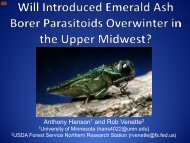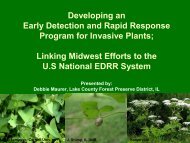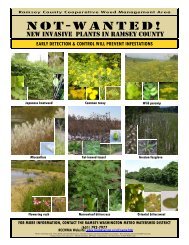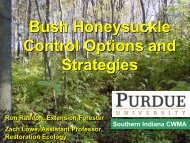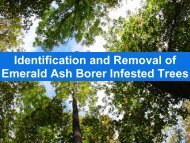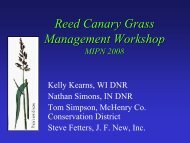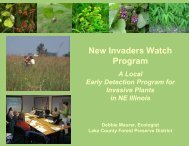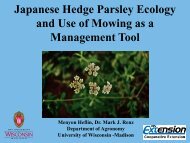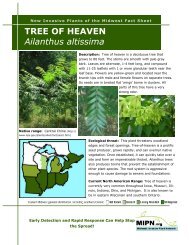CUT-LEAVED TEASEL Dipsacus laciniatus - Midwest Invasive Plant ...
CUT-LEAVED TEASEL Dipsacus laciniatus - Midwest Invasive Plant ...
CUT-LEAVED TEASEL Dipsacus laciniatus - Midwest Invasive Plant ...
You also want an ePaper? Increase the reach of your titles
YUMPU automatically turns print PDFs into web optimized ePapers that Google loves.
New <strong>Invasive</strong> <strong>Plant</strong>s of the <strong>Midwest</strong> Fact Sheet<strong>CUT</strong>-<strong>LEAVED</strong> <strong>TEASEL</strong><strong>Dipsacus</strong> <strong>laciniatus</strong>Description: Cut-leaved teasel is a perennial herb thatflowers once and then dies. The first year they form a lowgrowing rosette which then the second or third year producesa 2-6 foot stem. Leaves on the stems are opposite,long, deeply cut, prickly, and joined into a cup around thestalk. Stems are rigid and spiny. Flowers are small, whiteand in oval-shaped heads atop stems. They bloom summerinto the fall. Common teasel (D. fullonum) similar and invasive,but with purple flowers and the leaves not deeply cut.Native range: Throughout Europe(http://www.inhs.uiuc.edu/chf/outreach/VMG/teasel.html)Ecological threat: This plant threatens prairies andsedge meadows. They produce massive amounts ofseeds that can remain viable in the soil for severalyears. In addition the death of the mother plant providesan excellent environment for new seedling establishmentleading to dense monoculture populations.Current North American Range: Cut-leaved teasel iscurrently observed throughout the states of Missouri,Illinois, Indiana, Wisconsin, Michigan, Ohio, and southernOntario. It is also seen in southern Minnesota andIowa.Early Detection and Rapid Response Can Help Stopthe Spread!
<strong>CUT</strong>-<strong>LEAVED</strong> <strong>TEASEL</strong>, <strong>Dipsacus</strong> <strong>laciniatus</strong>MANAGEMENT OPTIONS: (https://www.dnr.state.oh.us/dnap/invasive/15teasel.htm)Mechanical methodsIndividual rosettes can be removed using a dandelion digger; removal of the entire root is essentialto eliminate re-sprouting. Flowering stalks may be cut down once the plant has initiated flowering,but if cut too soon plants may send up new flowering stalks. It has been shown that seeds will continueto develop and mature even after cutting. To prevent seed dispersal, the cut stalks should beremoved.Chemical methodsFoliar application of herbicides is effective and useful when mechanical treatments are not feasible.Herbicide, such as Roundup®, Glypro®, or Transline® should be applied to the rosette stage. Innatural areas, application during the late fall or early spring will result in less harm to non-targetedspecies.Biological methodsNo biological control methods are currently available.For more information on control and management of this species, please visit the followingWeb sites: www.usda.plants.gov, www.nps.gov/plants/alien/factmain.htm,tncweeds.ucdavis.edu/comtrol.html, dnr.wi.gov/invasives/plants.htm, www.invasivespeciesinfo.gov/plants/main.shtml, http://www.nps.gov/plants/alien/fact/pope1.htmEarly Detection and Rapid Response Can Help Stop theSpread!





